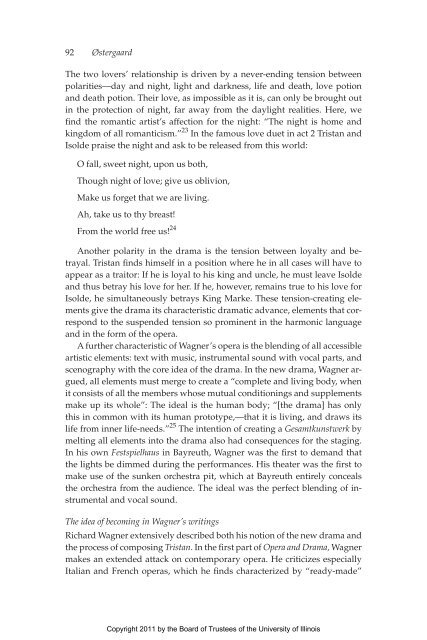Darwin and Wagner: Evolution and Aesthetic Appreciation - UMB
Darwin and Wagner: Evolution and Aesthetic Appreciation - UMB
Darwin and Wagner: Evolution and Aesthetic Appreciation - UMB
Create successful ePaper yourself
Turn your PDF publications into a flip-book with our unique Google optimized e-Paper software.
92 Østergaard<br />
The two lovers’ relationship is driven by a never-ending tension between<br />
polarities—day <strong>and</strong> night, light <strong>and</strong> darkness, life <strong>and</strong> death, love potion<br />
<strong>and</strong> death potion. Their love, as impossible as it is, can only be brought out<br />
in the protection of night, far away from the daylight realities. Here, we<br />
find the romantic artist’s affection for the night: “The night is home <strong>and</strong><br />
kingdom of all romanticism.” 23 In the famous love duet in act 2 Tristan <strong>and</strong><br />
Isolde praise the night <strong>and</strong> ask to be released from this world:<br />
O fall, sweet night, upon us both,<br />
Though night of love; give us oblivion,<br />
Make us forget that we are living.<br />
Ah, take us to thy breast!<br />
From the world free us! 24<br />
Another polarity in the drama is the tension between loyalty <strong>and</strong> betrayal.<br />
Tristan finds himself in a position where he in all cases will have to<br />
appear as a traitor: If he is loyal to his king <strong>and</strong> uncle, he must leave Isolde<br />
<strong>and</strong> thus betray his love for her. If he, however, remains true to his love for<br />
Isolde, he simultaneously betrays King Marke. These tension-creating elements<br />
give the drama its characteristic dramatic advance, elements that correspond<br />
to the suspended tension so prominent in the harmonic language<br />
<strong>and</strong> in the form of the opera.<br />
A further characteristic of <strong>Wagner</strong>’s opera is the blending of all accessible<br />
artistic elements: text with music, instrumental sound with vocal parts, <strong>and</strong><br />
scenography with the core idea of the drama. In the new drama, <strong>Wagner</strong> argued,<br />
all elements must merge to create a “complete <strong>and</strong> living body, when<br />
it consists of all the members whose mutual conditionings <strong>and</strong> supplements<br />
make up its whole”: The ideal is the human body; “[the drama] has only<br />
this in common with its human prototype,—that it is living, <strong>and</strong> draws its<br />
life from inner life-needs.” 25 The intention of creating a Gesamtkunstwerk by<br />
melting all elements into the drama also had consequences for the staging.<br />
In his own Festspielhaus in Bayreuth, <strong>Wagner</strong> was the first to dem<strong>and</strong> that<br />
the lights be dimmed during the performances. His theater was the first to<br />
make use of the sunken orchestra pit, which at Bayreuth entirely conceals<br />
the orchestra from the audience. The ideal was the perfect blending of instrumental<br />
<strong>and</strong> vocal sound.<br />
The idea of becoming in <strong>Wagner</strong>’s writings<br />
Richard <strong>Wagner</strong> extensively described both his notion of the new drama <strong>and</strong><br />
the process of composing Tristan. In the first part of Opera <strong>and</strong> Drama, <strong>Wagner</strong><br />
makes an extended attack on contemporary opera. He criticizes especially<br />
Italian <strong>and</strong> French operas, which he finds characterized by “ready-made”<br />
Copyright 2011 by the Board of Trustees of the University of Illinois

















